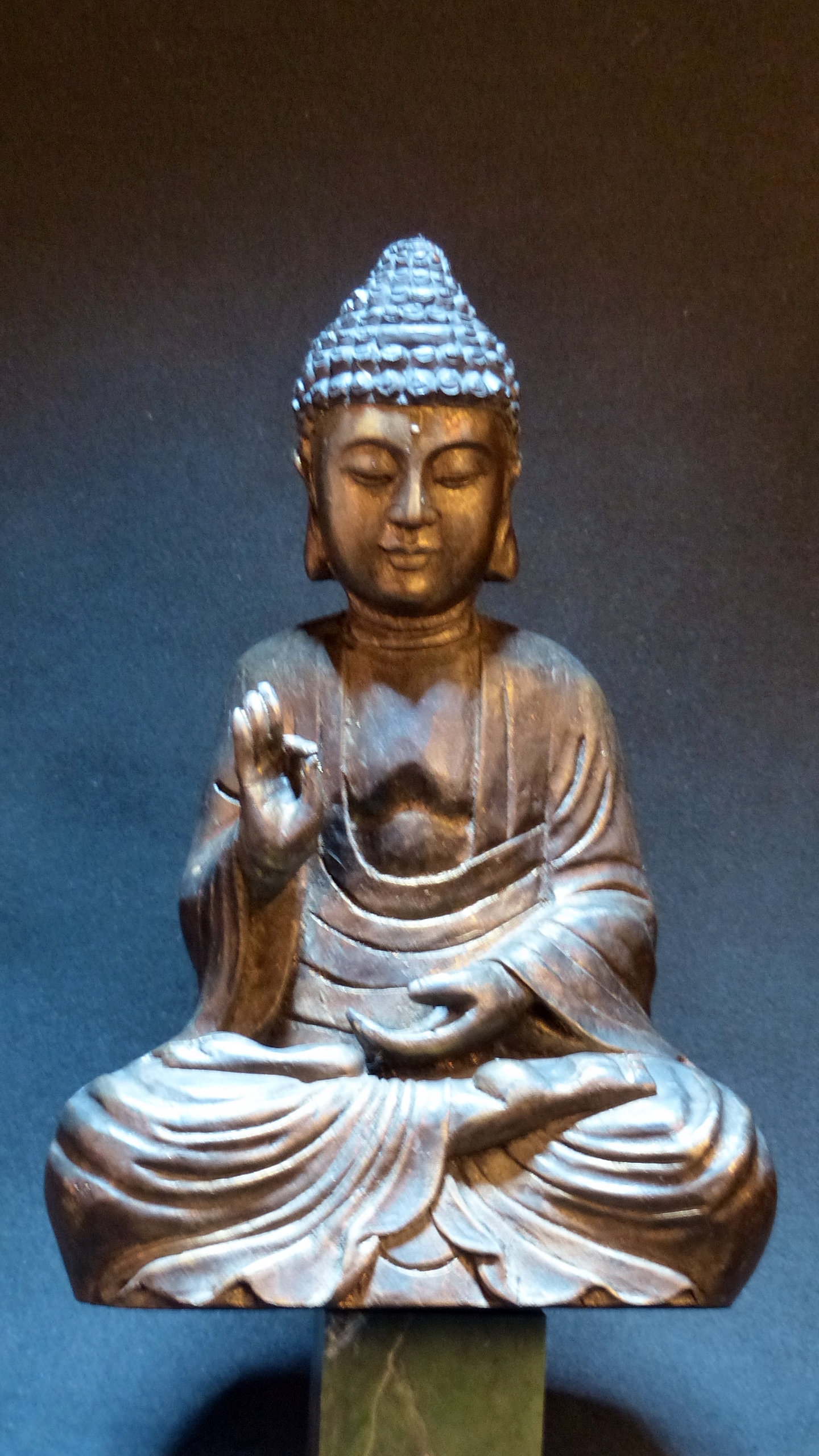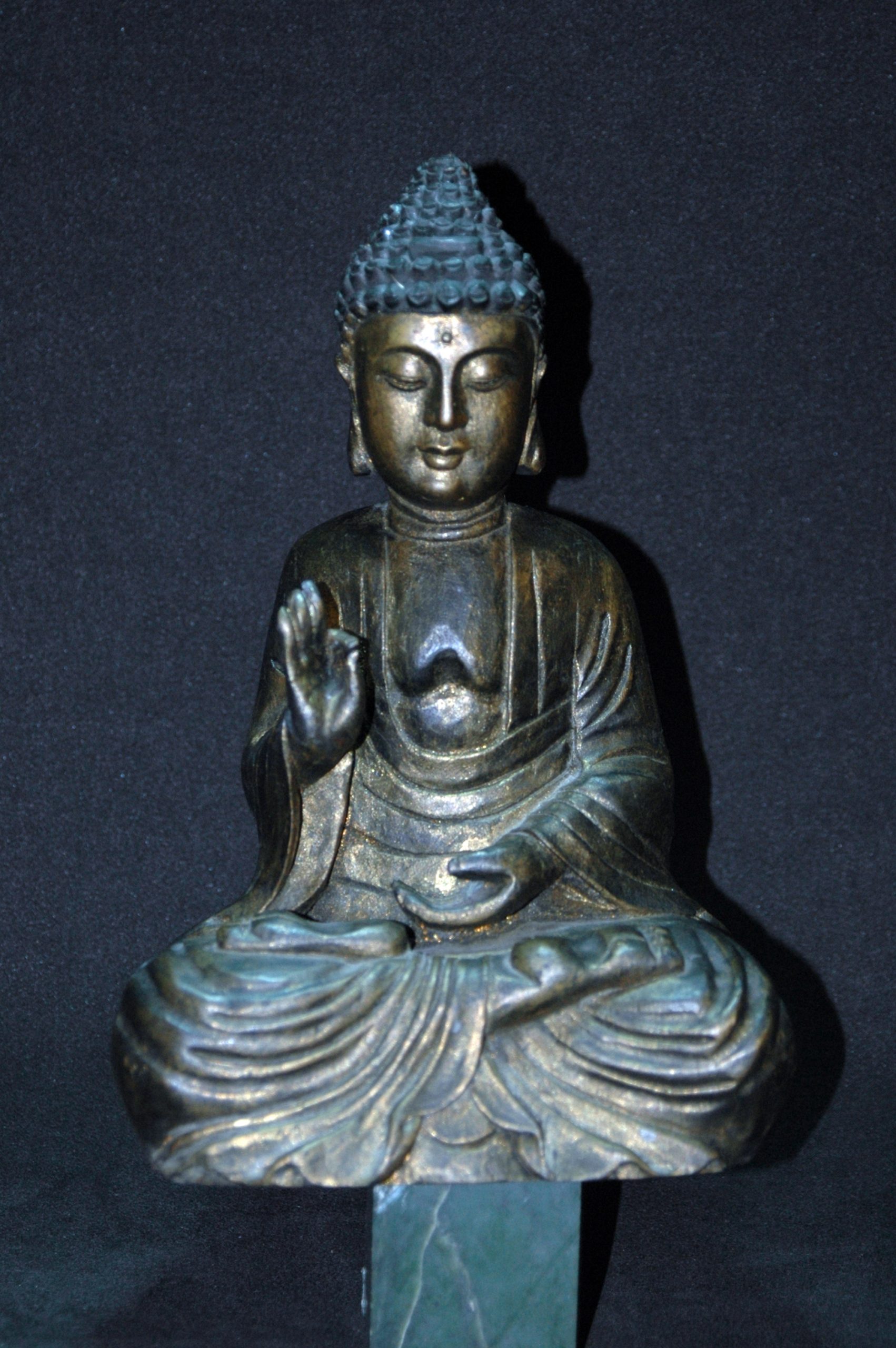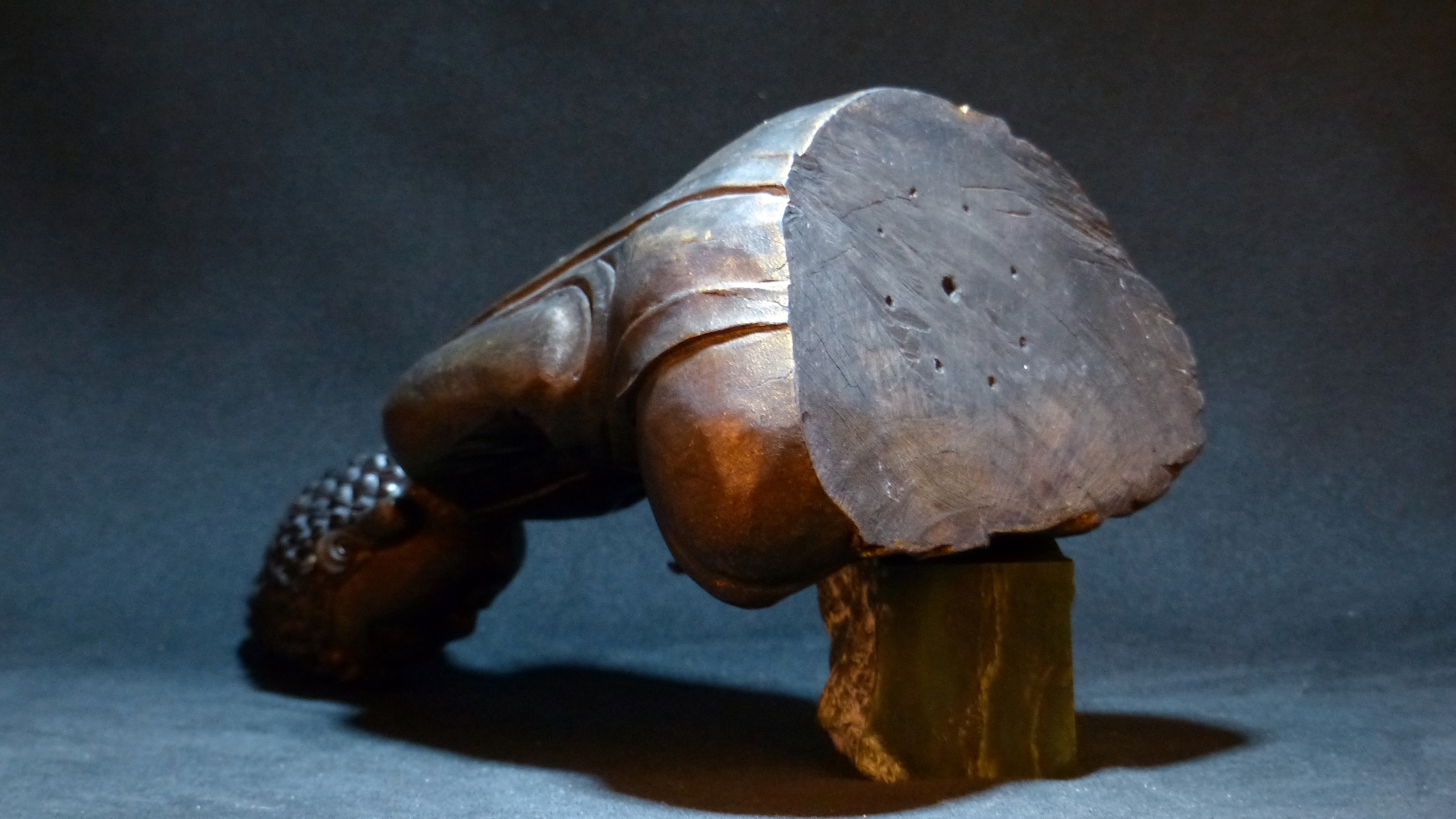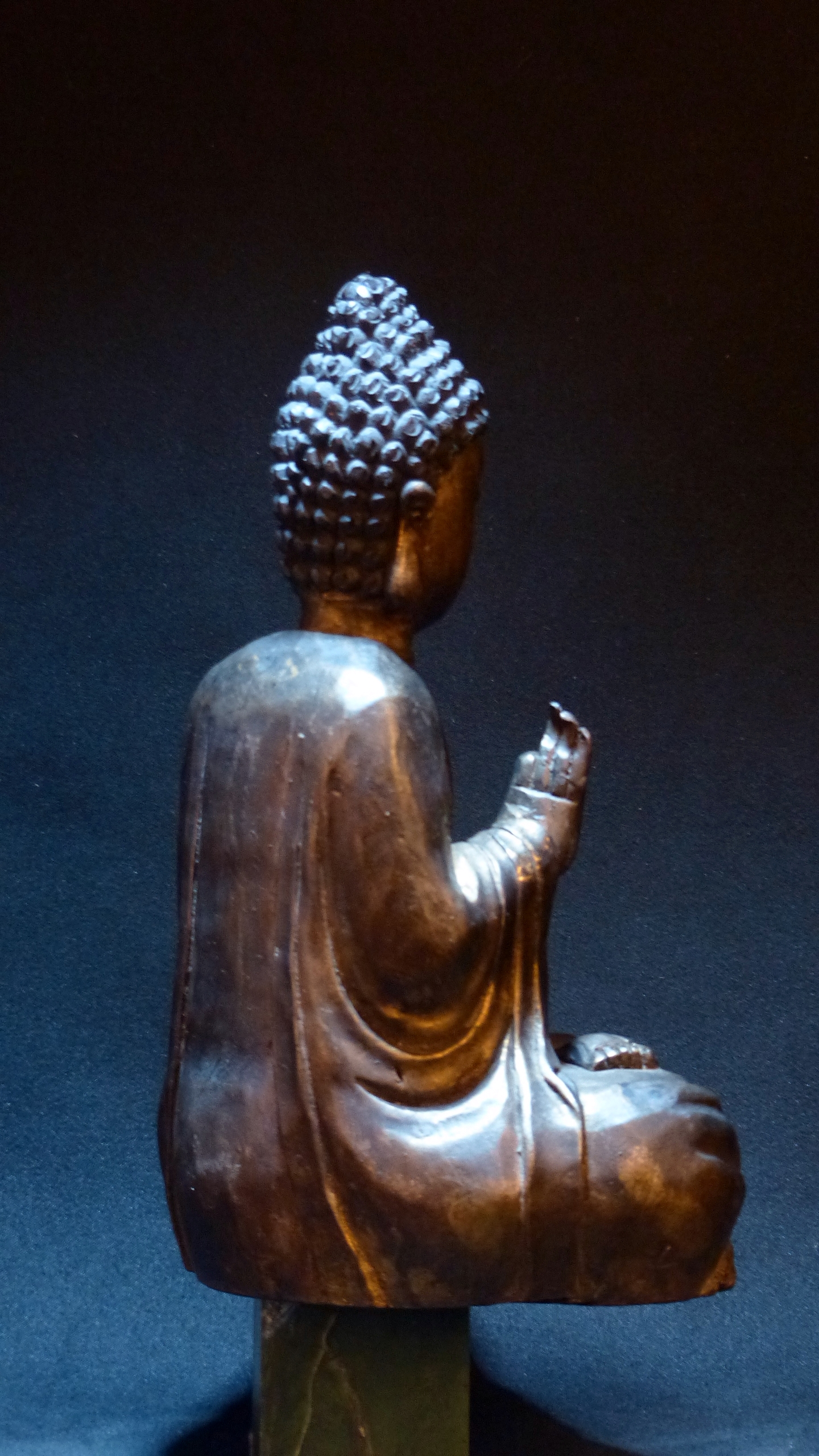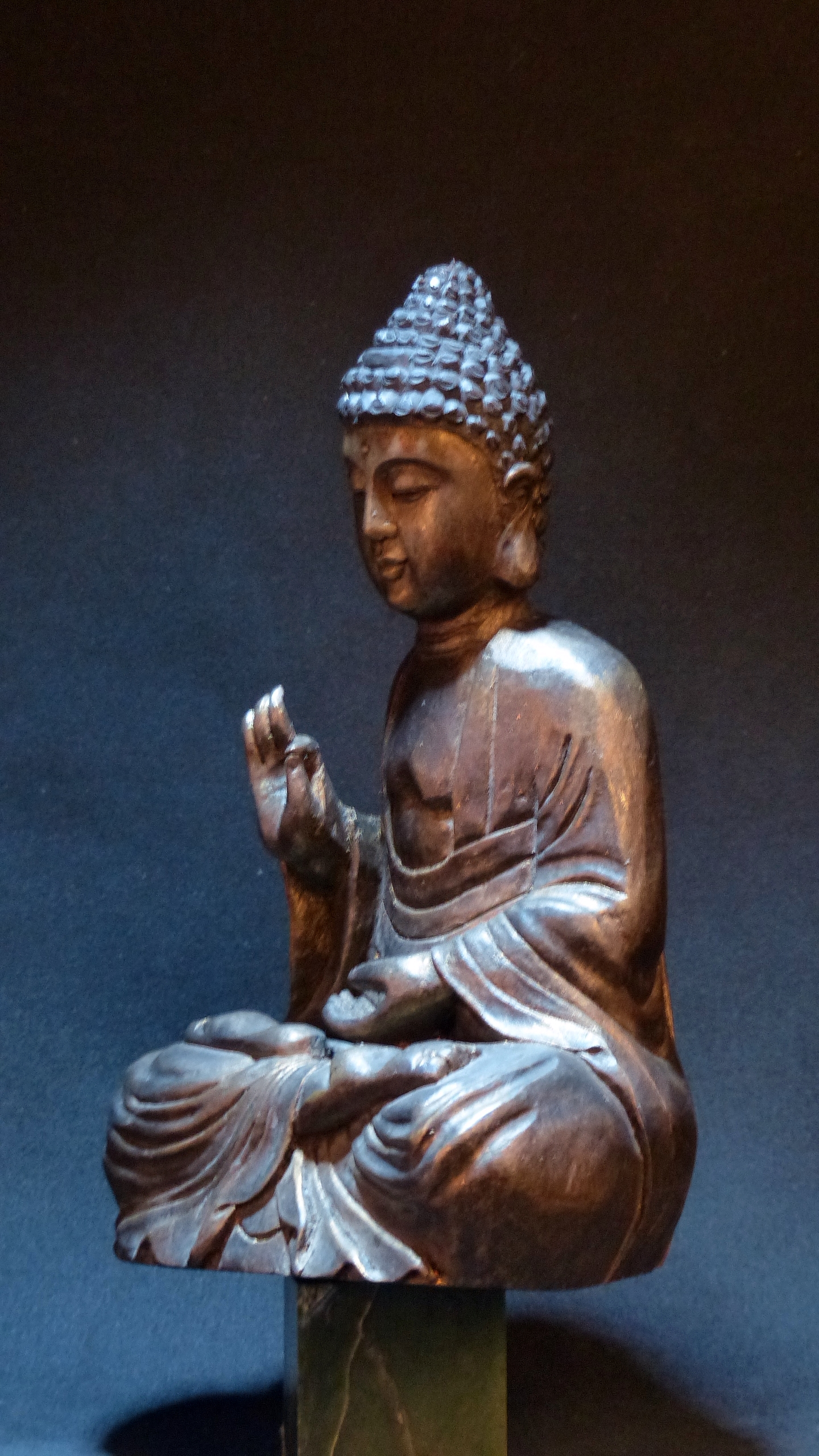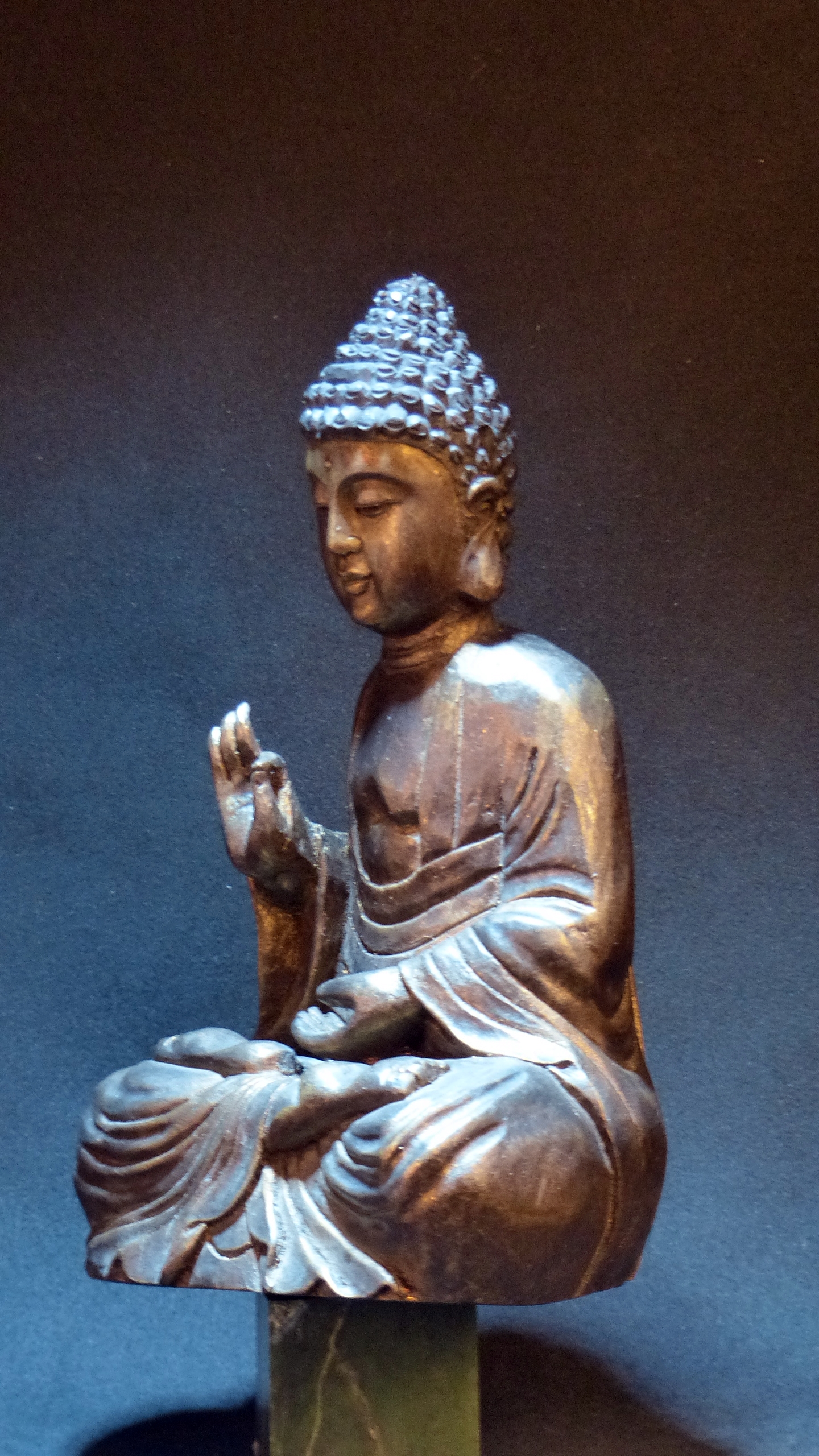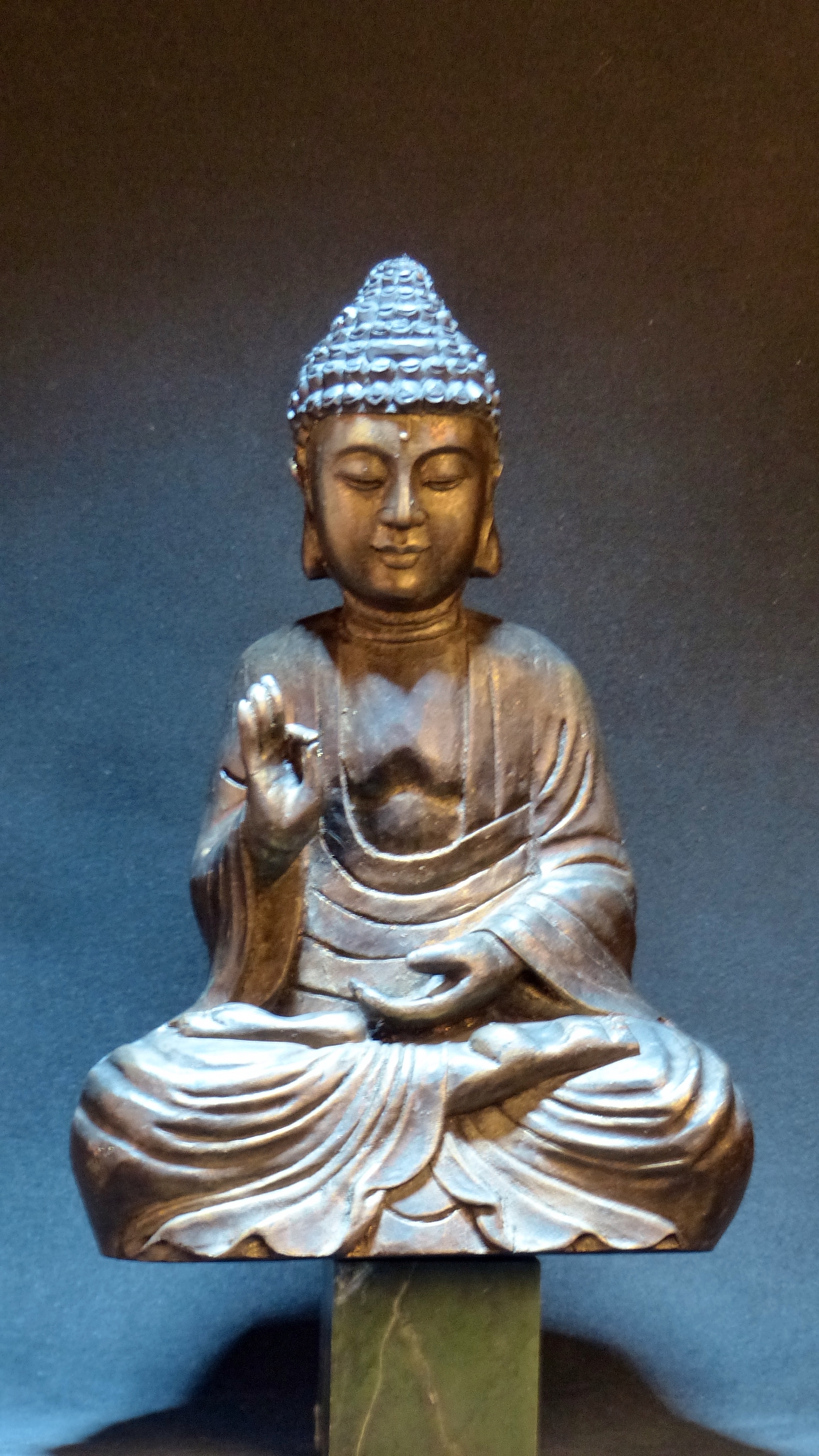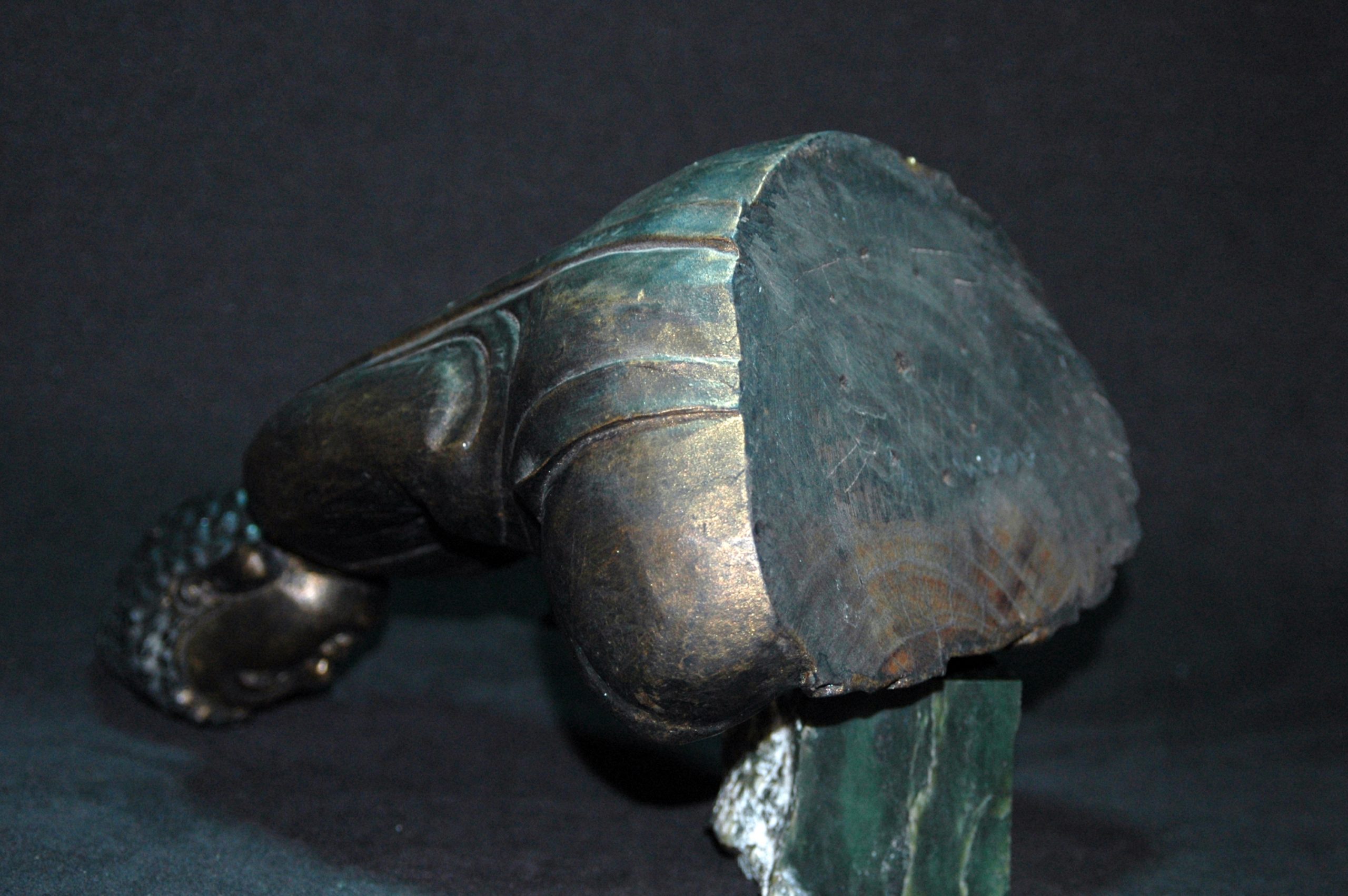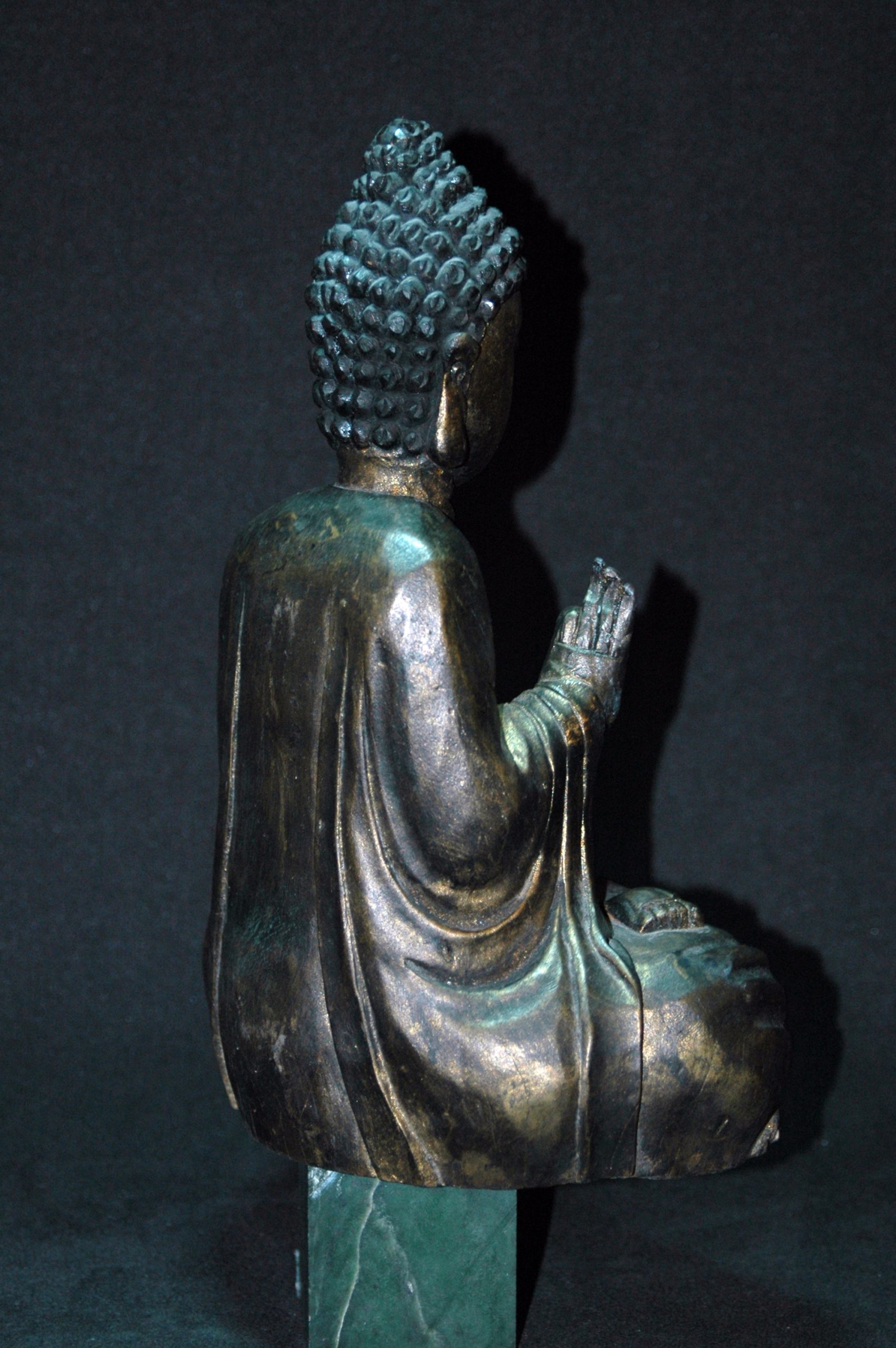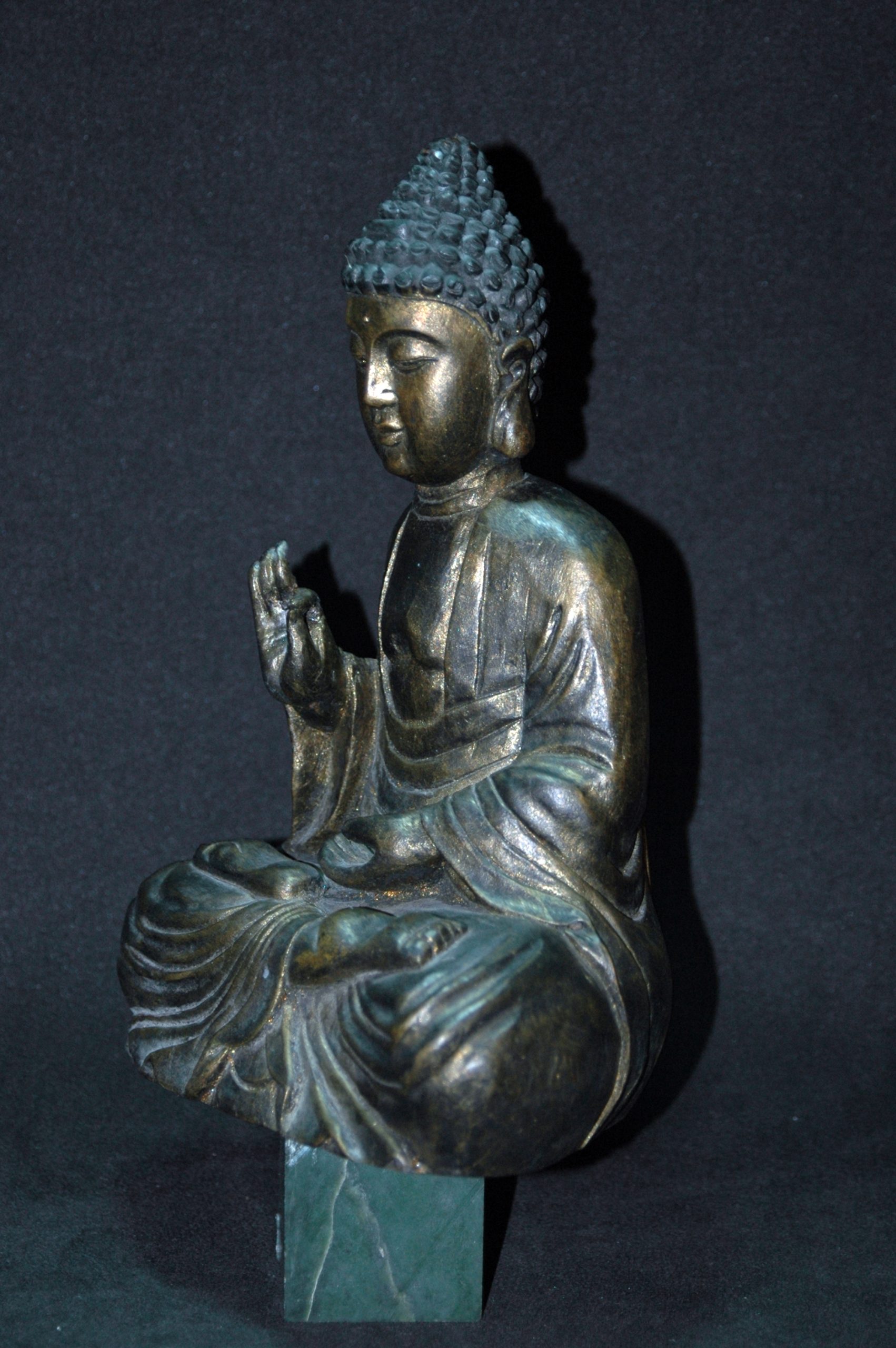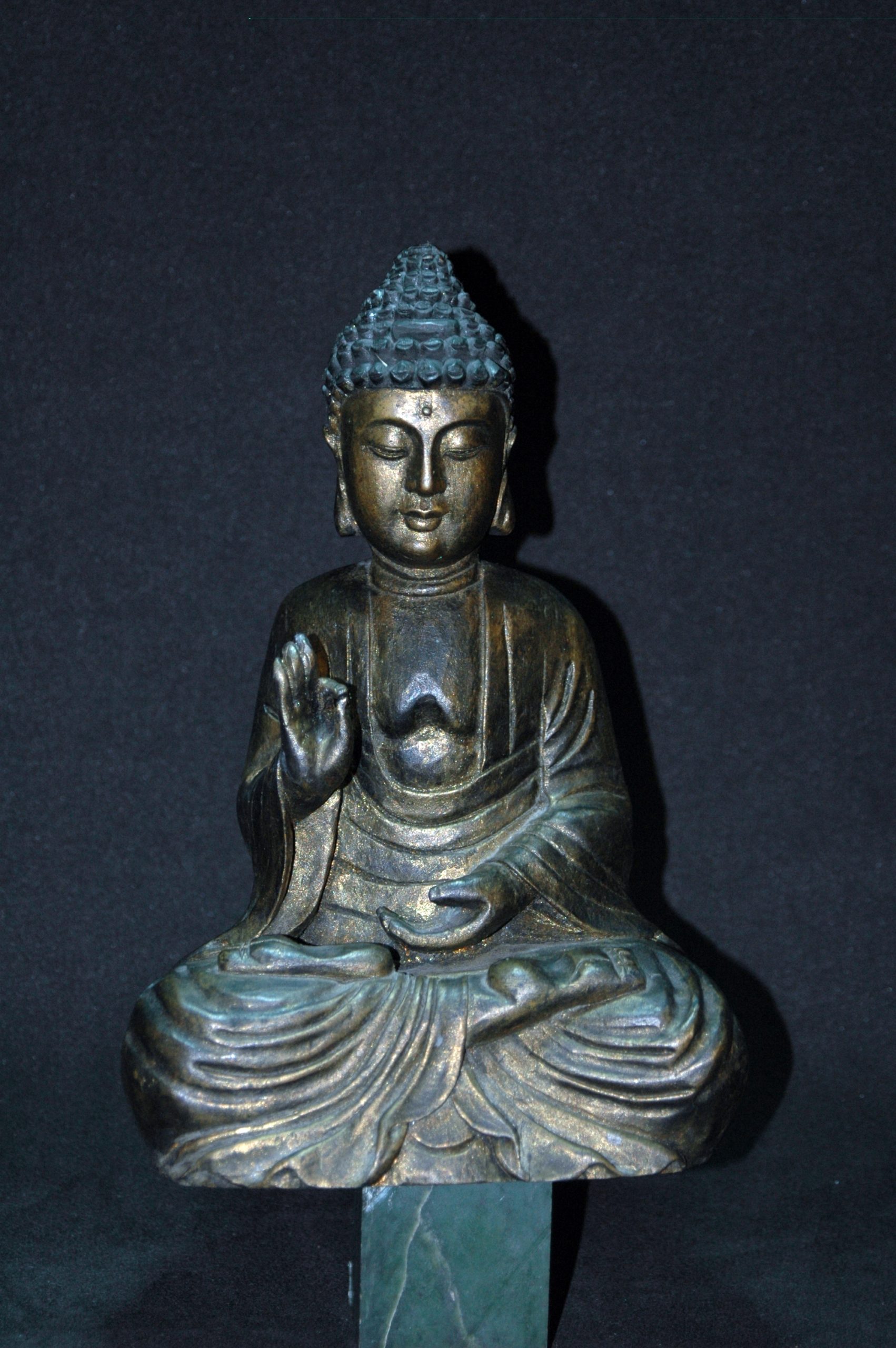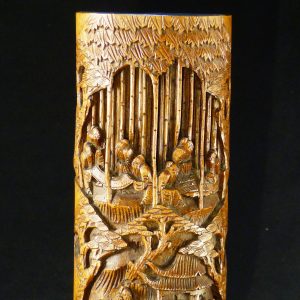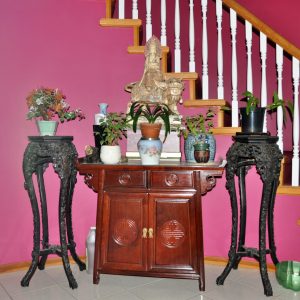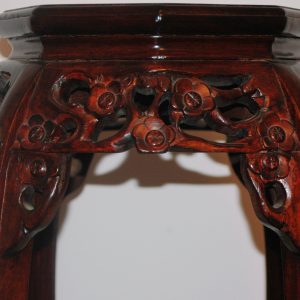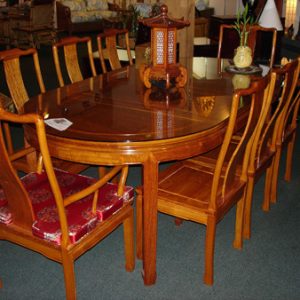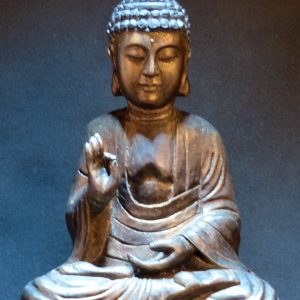Description
鎏金释迦牟尼木佛
明 木胎髹漆金释迦牟尼
参考:嘉德2014 秋季拍賣
觀古 – 瓷器珍玩工藝品
1214 明 木雕無量壽佛
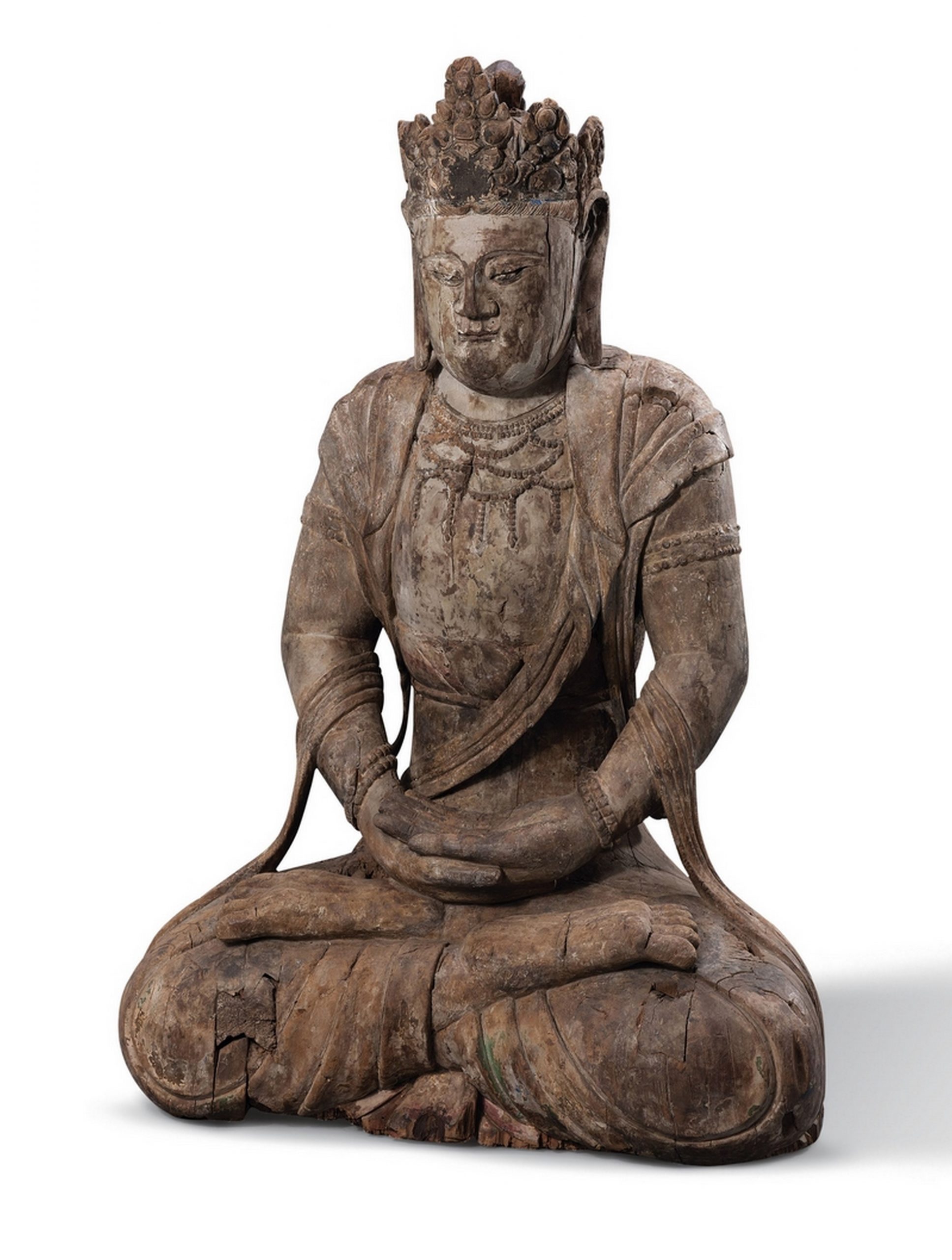
估價 : HKD: 700,000-1,000,000 USD 90,323-129,032
72 cm. (39 3/8 in.) high
無量壽佛佛名為阿彌陀,意譯為無量壽(梵文Amitayus),故阿彌陀佛亦稱為無量壽佛、無量光佛。無量壽經卷上言,無量壽佛,威神光明,最尊第一。於密教為五佛中之西方尊。此無量壽佛以全跏趺坐,雙手腹前施禪定印,身著天衣長裙,衣紋光潔覆至腳踝,披帛斜繞胸前而過搭於後心。胸前佩戴項鍊及瓔珞,面龐圓潤,微微含笑,雙目微闔,頭戴五葉寶冠,髮髻高束,兩邊各有帔帛繒帶搭於臂腕。佛像後心遺留空洞,應曾有裝藏。表面彩繪因時間歷經風雨侵蝕而斑駁,但整體保存極為完整,具有明代造像的鮮明特徵,現存世數量極少,堪為稀有難得木雕佛像之
参考: 西泠印社
2016年秋季拍卖会
华藏宝相·历代造像艺术专场
图录号: 3712清•木漆金释迦牟尼坐像
QING DyNASTY A GOLDEN-PAINTED WOOD STATUE OF SAKYAMUNI
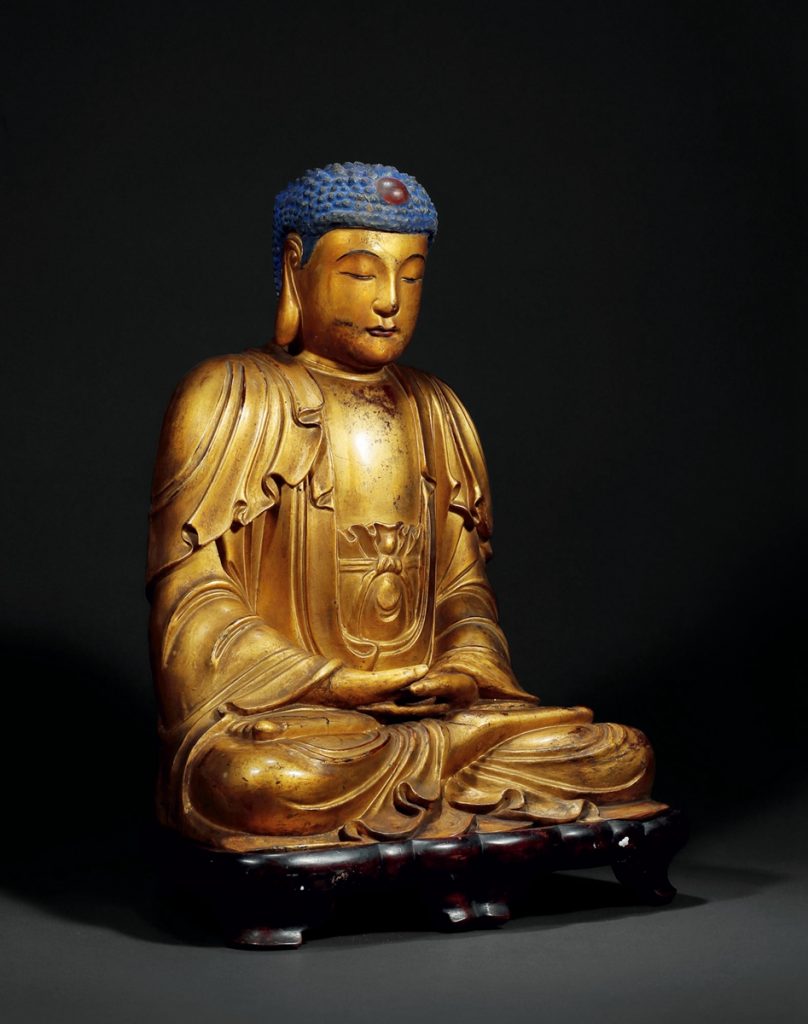
估价RMB: 230,000-250,000
成交价RMB: 287,500(含佣金)
高:53cm
此尊释佛像身披法衣,结全跏趺坐,双手执禅定印于脐前。螺发排列规整,面庞圆润,宽额高鼻,双目垂视,嘴含微笑,神态庄重慈祥。整像以木胎雕制,漆金于外,衣纹采用内地传统的写实手法,有较强质感。
此像躯体浑厚,造型敦实,比例匀称,动态舒展,线条流畅,体态优美大方,眉细目长,额阔唇薄,皆为清代代中原地区造像特征,值得珍之。
参考:佳士得
8 6月 2015 | 現場拍賣 4024
亞洲藝術
拍品 338
STATUE DE GUANYIN EN BOIS LAQUE OR
明 約十六世紀 木漆金觀音坐像
CHINE, DYNASTIE MING, CIRCA XVIEME SIECLE
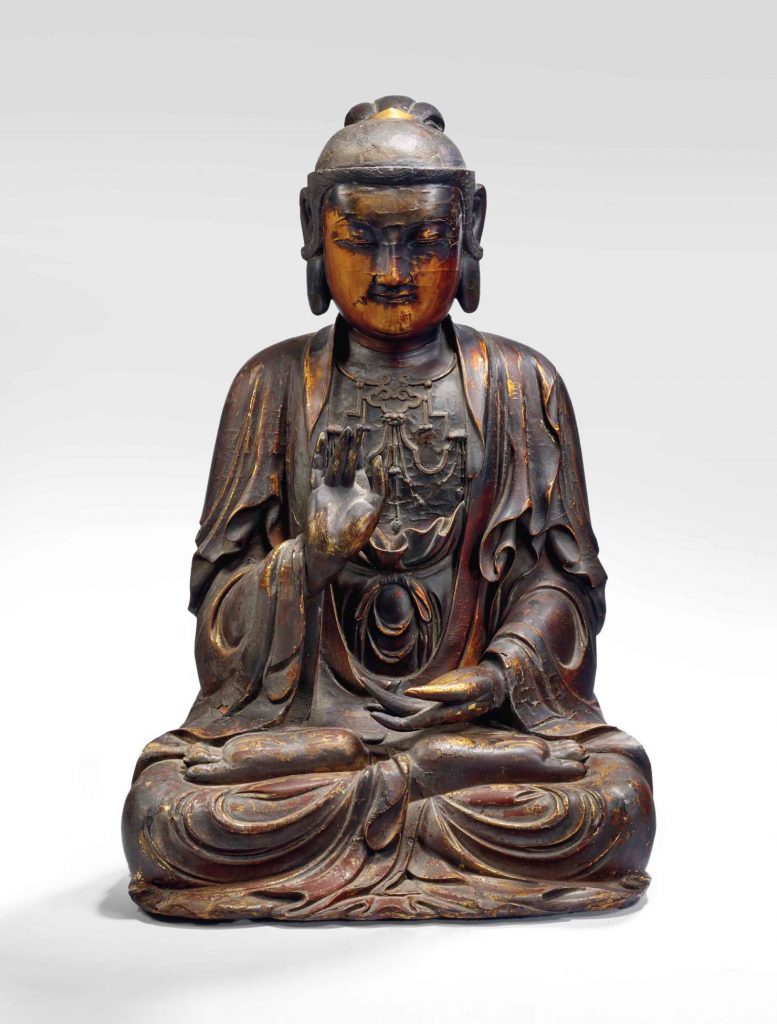
成交價 EUR 37,500
估價 EUR 15,000 – EUR 20,000
A GILT-LACQUERED WOOD FIGURE OF GUANYIN
CHINA, MING DYNASTY, CIRCA 16TH CENTURY
参考:苏富比
Collection Particulière Française
法國私人收藏
28
Exceptionnelle statue du Bouddha Maravijaya en alliage de cuivre doré Royaume de Dali (937-1253),
Province de Yunnan, XIIE siècle
大理國 十二世紀 鎏金銅合金釋迦牟尼佛坐像
An exceptional gilt-copper alloy figure of Buddha Maravijaya, Dali Kingdom (937-1253),
Yunnan Province, 12th century
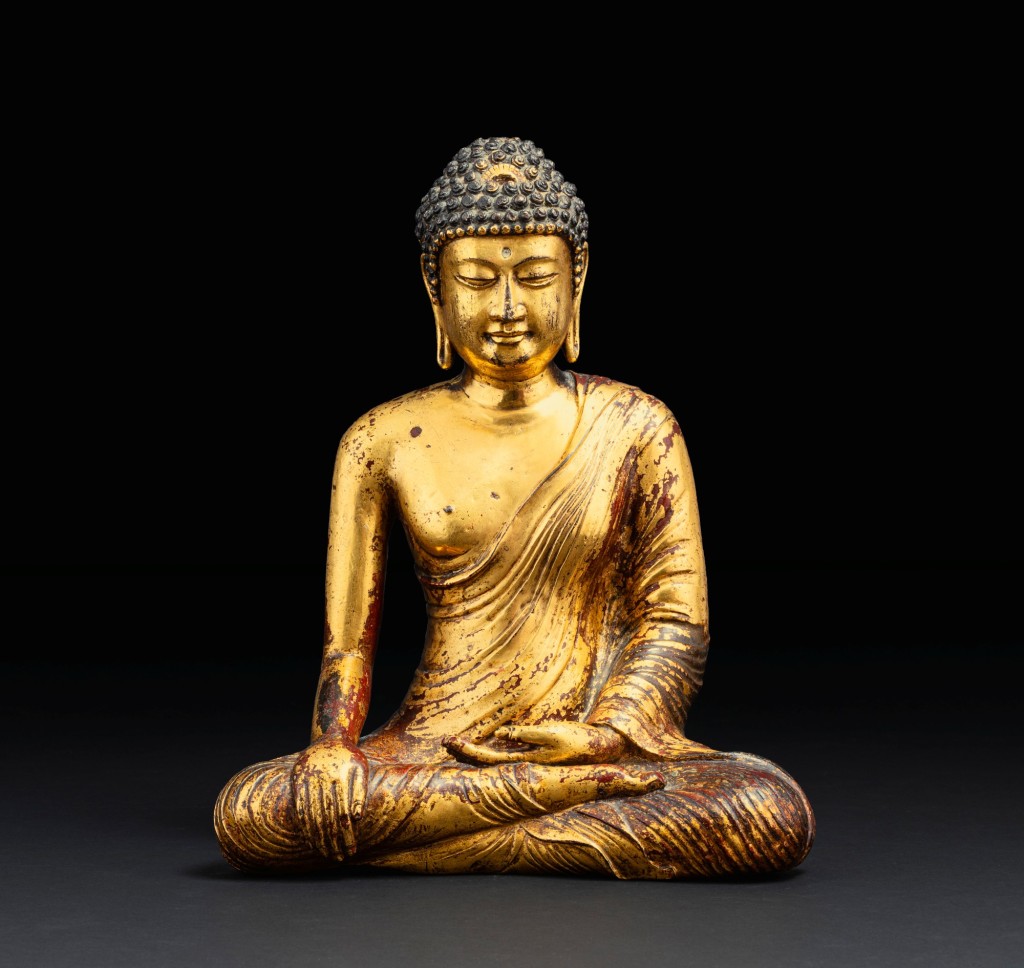
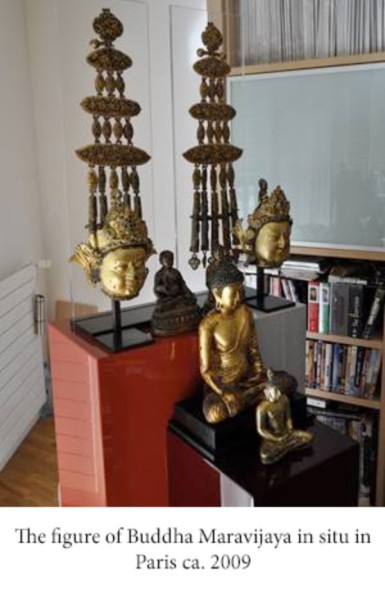
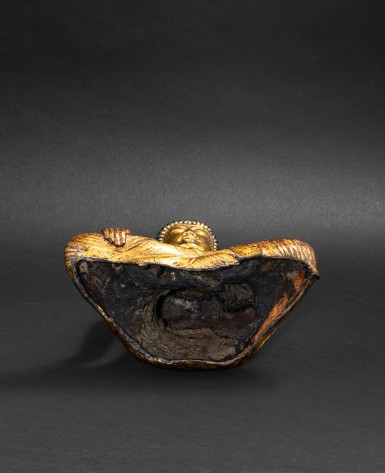
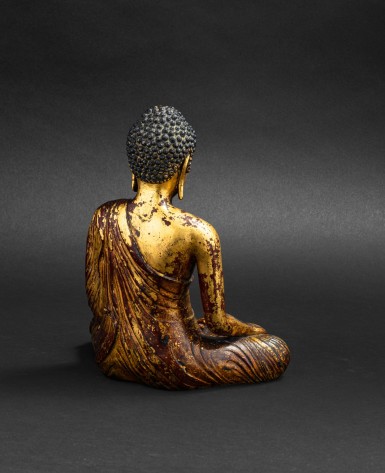
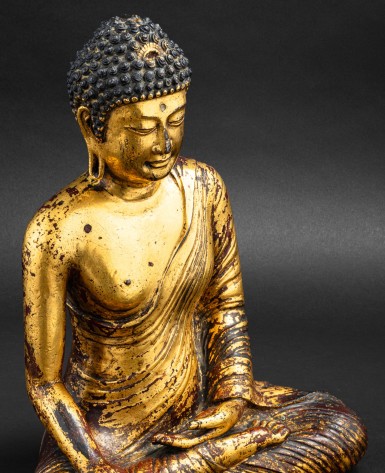
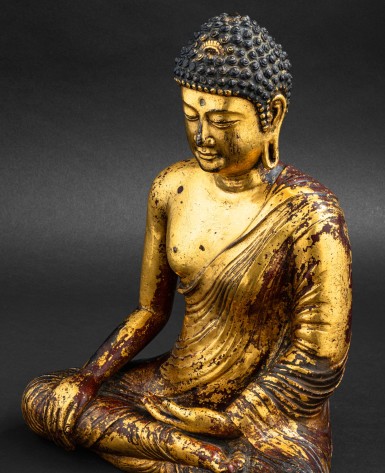
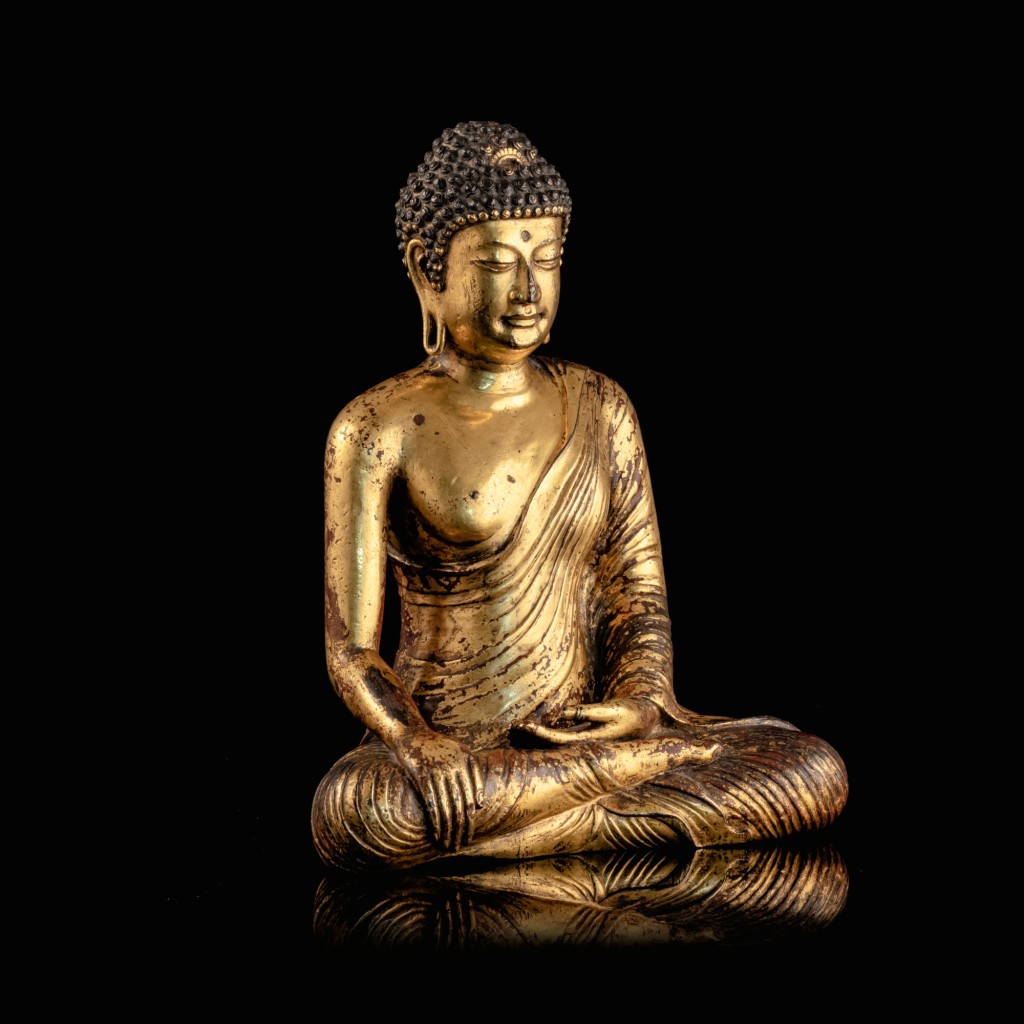
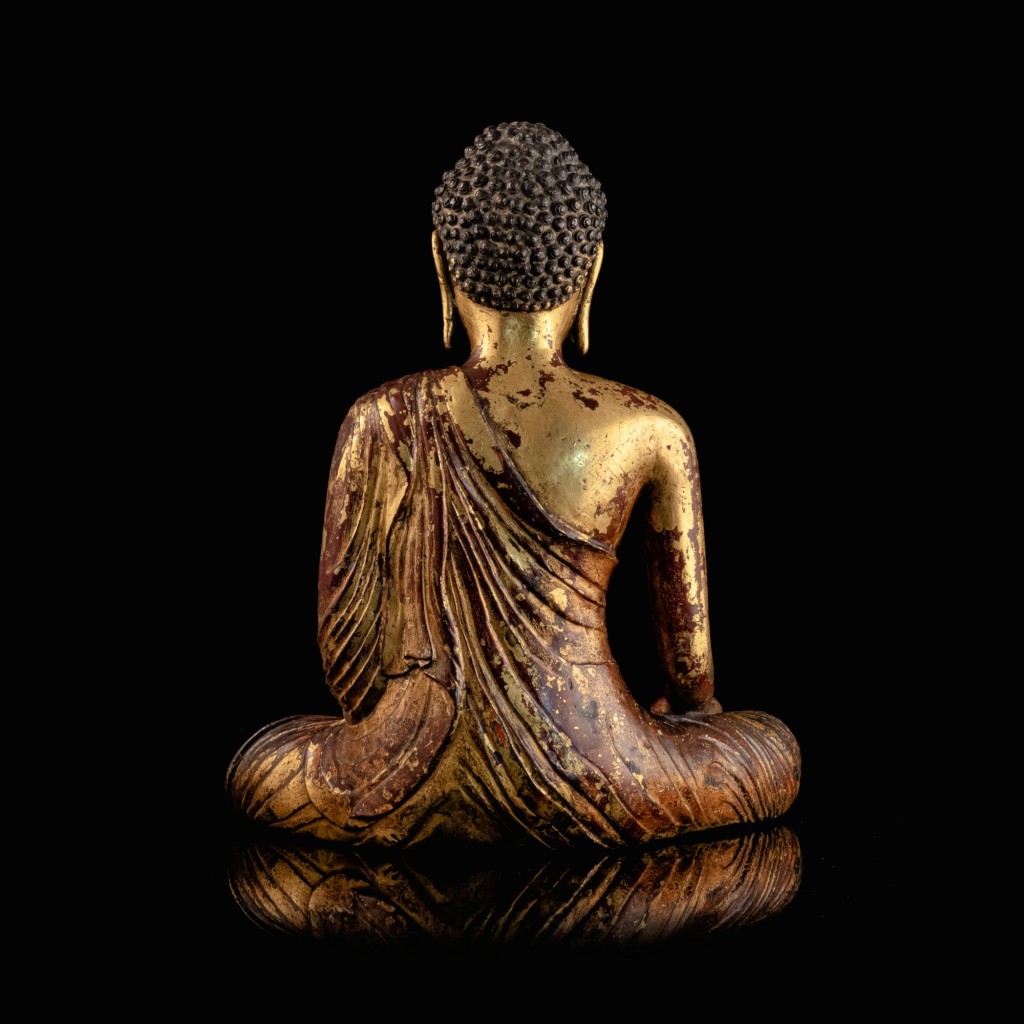

Estimate:200,000 – 300,000 EUR
Lot sold:2,674,500EUR
Description
Collection Particulière Française
法國私人收藏
Exceptionnelle statue du Bouddha Maravijaya en alliage de cuivre doré Royaume de Dali (937-1253), Province de Yunnan, XIIE siècle
大理國 十二世紀 鎏金銅合金釋迦牟尼佛坐像
An exceptional gilt-copper alloy figure of Buddha Maravijaya, Dali Kingdom (937-1253), Yunnan Province, 12th century
finement sculptée et richement dorée, le bouddha assis en padmasana, les mains en bhumisparsa mudra, vêtue d’une riche robe monastique plissée laissant l’épaule droite et le bras découverts, le visage serein aux yeux mi-clos sous l’urna, les oreilles aux longs lobes, la chevelure coiffée de petites boucles retenues en un chignon orné de l’ushnisha
30,7 cm, 12⅛ in.
30.7 公分, 12⅛英寸
Condition Report
The magnificent figure is finely and heavily cast. There are some characteristic wear to the gilding, especially to the legs, to the arms and to the back, but overall the gilding has been very well preserved. There are some light surface wear and minute dents along the edges, including a small dent to the nose as visible on the catalogue photo as well as a small dent to the rear of the figure’s left shoulder which is lighlty pushed in in one area at the back.
造像精緻厚實,鎏金保存良好,略見磨損,尤其腿部、雙臂、背。通體表面輕微磨損,邊角略見細小磕碰,包括鼻樑小磕、及左肩後一處小磕,稍見凹陷。
Catalogue Note
Buddhism in the Dali kingdom developed between 927 and 1253 as a distinctive interpretation of the faith, combining the worship of Buddhas and bodhisattvas — including the bodhisattva Acuoye Guanyin, known as “Luck of Yunnan” (Fig.1), the emblematic tutelary deity unique to Dali culture — and tantric elements of esoteric vajrayana Buddhism popular in Tibet and originating in eastern India during the Pala period (7th-12th c). Tantric ritual was part of Buddhist practise in the kingdom, evidenced by bronze and gilt bronze thunderbolt sceptres (vajra) and ritual daggers (kila) of the period, many now in the Yunnan Provincial Museum, Kunming, see Albert Lutz, ed., Der Goldschatz der Drei Pagoden, Zürich, 1991, pp. 218-21, cat. nos. 77-81. The Dali Buddhist pantheon included peaceful and wrathful multi-armed gods envisioned as meditational deities and guardians of the faith. Like the idiosyncratic iconography, the Dali sculptural style is distinct from neighbouring Buddhist cultures in China and Tibet.
大理國(927至1253年)佛教發展,融合佛、菩薩信仰,及藏傳佛教,源自東印度帕拉傳統,包括阿嵯耶觀音備得信眾景仰,又稱為「雲南福星」(Fig.1),深植大理宗教文化,為其特色。昆明雲南省博物館藏大理國鎏金銅製金剛杵、金剛橛,可相證當時亦有藏式佛典,見 Albert Lutz 編,《Der Goldschatz der Drei Pagoden》,蘇黎世,1991年,頁218-21,編號77-81。大理佛教神祇涵蓋慈悲像及憤怒像,造像風格受西藏、中國影響。


©MUSEUM PURCHASE WITH FUNDS PROVIDED BY THE HELEN M. TOWLE BEQUEST / BRIDGEMAN IMAGES
The statues of Acuoye Guanyin seemed to have been influenced by the artistic traditions of Yunnan’s neighbouring kingdom of Champa in present-day Vietnam, itself based on styles originally imported from South India through Indonesia. Seated figures of Buddha, including the present example, are almost invariably depicted with legs crossed (Fig.2) in the ‘noble posture’ (sattvaparyankasana), where one leg rests on top of the other, rather than the more common yogic posture (vajraparyankasana) where the legs are crossed at the ankle with the soles of both feet visible. The fingers of the right hand clasp the leg rather than extend towards the ground as they do in the common interpretation of the ‘earth-touching gesture’ (bhumisparsha mudra), cf. the similar hand gesture of the Dali bronze Maravijaya Buddha in the Yunnan Provincial Museum, see Lutz, ibid, p. 169, pl. 43.
阿嵯耶觀音之形像則見鄰近國占婆(現越南)藝術之風,可前溯至南印、印尼傳統。坐姿佛像,如本例,多為半跏趺坐 (Fig.2),一腿疊於另一之上,而非全跏坐,雙腿腳踝相疊,腳掌朝上可見。右手輕置於腿上,而非指尖點地,結觸地印,參考雲南省博物館藏大理國佛坐像,手印相似,錄於 Lutz ,同上,頁169,圖版43。

All these influences are visible on the famous Scroll of Buddhist Images byZhang Shengwen (Fig. 3), the only surviving painting from the Dali kingdom, in what is now Yunnan and roughly concurrent with the Song dynasty, and considered a Treasure of Nantian. This rare sculpture belongs to a group of distinctive bronze figures produced in Yunnan in southwestern China during the rule of the Dali Kingdom from the 10th to 13th centuries, which display a unique blend of Chinese and Southeast Asian influences.
Buddha images in this group have similar characteristic facial features with half-open eyes, broad noses and prominent lips. Images from the Dali Kingdom were not recognized as such and were often misattributed. In 1944, American scholar Helen Burwell Chapin, who had studied and published the Yunnanese artist’s Zhang Shengwen’s Long Scroll of Buddhist Images, discovered that a group of bronze images in Western collections actually originated in Yunnan. She published her findings in her ground-breaking article ‘Yunnanese Images of Avalokitesvara’, Harvard Journal of Asiatic Studies, vol. 8, 1944, pp. 131-186. Since then, many images have been reattributed as being from the Dali Kingdom
大理國與宋朝幾近同代,位處中國西南方、當今雲南一帶。張勝溫的《大理國描工畫梵像》,乃大理國唯一傳世畫作,素有「南天瑰寶」之美譽。卷軸中,上述的藝術風格清晰可見(圖三)。此尊屬於大理國十至十三世紀的造像,極為珍罕,與同類佛像臉容特徵相近,雙目微張、寬鼻豐唇,展現中原與東南亞藝風的交流與融合。大理佛像辨識非易,常有誤差,直到1944年美國學者 Helen Burwell Chapin 仔細研究張勝溫的《大理國描工畫梵像》,發表專文〈Yunnanese Images of Avalokitesvara〉,《Harvard Journal of Asiatic Studies》,卷8,1944年,頁131-186,指部分西方收藏青銅佛像應屬雲南所出,才讓我們對這類佛像重新認識,對大理佛教造像研究甚有裨益。

The beaded semi-circular style of the jewel (chintamani) appearing at the front of the domed cranial protuberance (ushnisha) is common throughout Buddha images in Dali sculpture (Fig. 4), and rarely seen elsewhere, cf. the two seated Buddhas in the Nitta Collection, see National Palace Museum, The Crucible of Compassion and Wisdom, Taipei, 1987, pp. 184-5. pls. 88, 89: the jewel symbolises the Buddha’s status as world sovereign (chakravartin).
肉髻前綴半圓形如意寶珠,可見於多數大理佛造像 (Fig. 4),參考國立故宮博物院藏二尊坐佛,出自彭楷棟舊藏,刊於《金銅佛造像特展圖錄》,台北,1987年,頁184-5,圖版88、89:寶珠象徵佛乃轉輪聖王。

The undulating robe style is a consistent feature of Dali Buddha sculpture, most often draped from the left shoulder leaving the right shoulder bare, and with the cloth reaching down to cover the ankle of the right foot, cf. the flowing robe style of the Amitabha Buddha in the Nitta Collection with its elegant movement of cloth across the chest, see National Palace Museum, ibid. p. 185. pl. 89 (Fig.5); and the similar robe style of the Amitabha Buddha in the Cleveland Museum of Art dated 1043, the second year of the Shenming reign of the Dali kingdom (Fig. 6), https://www.clevelandart.org/art/1942.1082.
本像衣袍樣式符合大理佛造像傳統,多披於左肩,右肩裸露,衣沿覆蓋右腳踝,一如彭楷棟舊藏阿彌陀佛像,胸前衣褶優雅垂墜,見國立故宮博物院,同上,頁185,圖版89;克里夫蘭博物館藏阿彌陀佛像,衣著亦類同,紀年1043年,大理盛明二年 (Fig. 6),https://www.clevelandart.org/art/1942.1082 。

RIGHT: FIG. 6 GILT BRONZE FIGURE OF AMITABHA, YUNNAN PROVINCE, DALI KINGDOM , (938–1253), THE CLEVELAND MUSEUM OF ART.
The lacquer finish over the mercury gilding is common in Dali sculpture, such as the Acuoye in the San Diego Museum (Fig. 7 and 8) commissioned by the Dali king Duan Zhengxing (r. 1147-1172) see Lutz, op. cit., p. 17, and the seated Dali Buddha in the Shanghai Museum, https://www.cepolina.com/museum-Shanghai-Buddha-gilt-bronze.html: lacquer enhances the richness of the gilding in its original application, darkening over time. This rare fire-gilt bronze remains one of the largest images of Buddha Maravijaya from the Dali kingdom.

©MUSEUM PURCHASE WITH FUNDS PROVIDED BY THE HELEN M. TOWLE BEQUEST / BRIDGEMAN IMAGES
RIGHT: FIG. 8 DETAIL OF THE BACK.
“THE LACQUER FINISH OVER THE MERCURY GILDING IS COMMON IN DALI SCULPTURE”
The iconographic form, in which the historical Buddha is seated with legs crossed in sattvaparyankasana and right hand in bhumisparsha mudra (Fig. 9) recalls the Buddha’s triumph over the demon Mara (maravijaya) just prior to his enlightenment. Having vowed to remain in meditation until he penetrated the mysteries of existence, Shakyamuni was visited by the demon Mara and his hoard of sorcerers and seductresses. The Buddha remained unmoved by the temptations with which Mara sought to deflect him from his goal, and moved his hand from the meditation posture in his lap towards the ground, to call the earth to witness his resolve. Mara’s hoard dispersed leaving the Buddha to attain enlightenment. The episode took place at the adamantine site (vajrasana) at Bodh Gaya, eastern India. The site is said to have been especially empowered to expedite the Buddha’s enlightenment.
釋迦牟尼像,以禪定冥想的坐姿,右手下垂持觸地印 (Fig. 9),這様的圖像説明在佛陀證悟真理之前戰勝魔羅的重要事蹟。那時,佛陀立下誓約將保持禪定冥想的姿態,直到透悟真理實相為止,魔羅試圖讓佛陀分心,然而對於一切試圖破壞佛陀追及理想的種種誘惑,佛陀均不為所動。最後,禪定坐姿的釋迦牟尼移動膝上的右手,觸碰大地,並説「請大地為證」,以此堅定不移的動作使得魔羅,魔軍與女色誘惑潰散敗逃,留下釋迦牟尼獨自在菩提樹下的金剛座(vajrasana)體驗偉大的覺悟。這個場景是發生在印度東部的菩提迦耶,據説該地擁有奇特的力量,加快促成了佛陀的覺悟。

参考:苏富比 421
中國藝術品
香港私人舊藏
清末至民國 木雕釋迦牟尼佛坐像
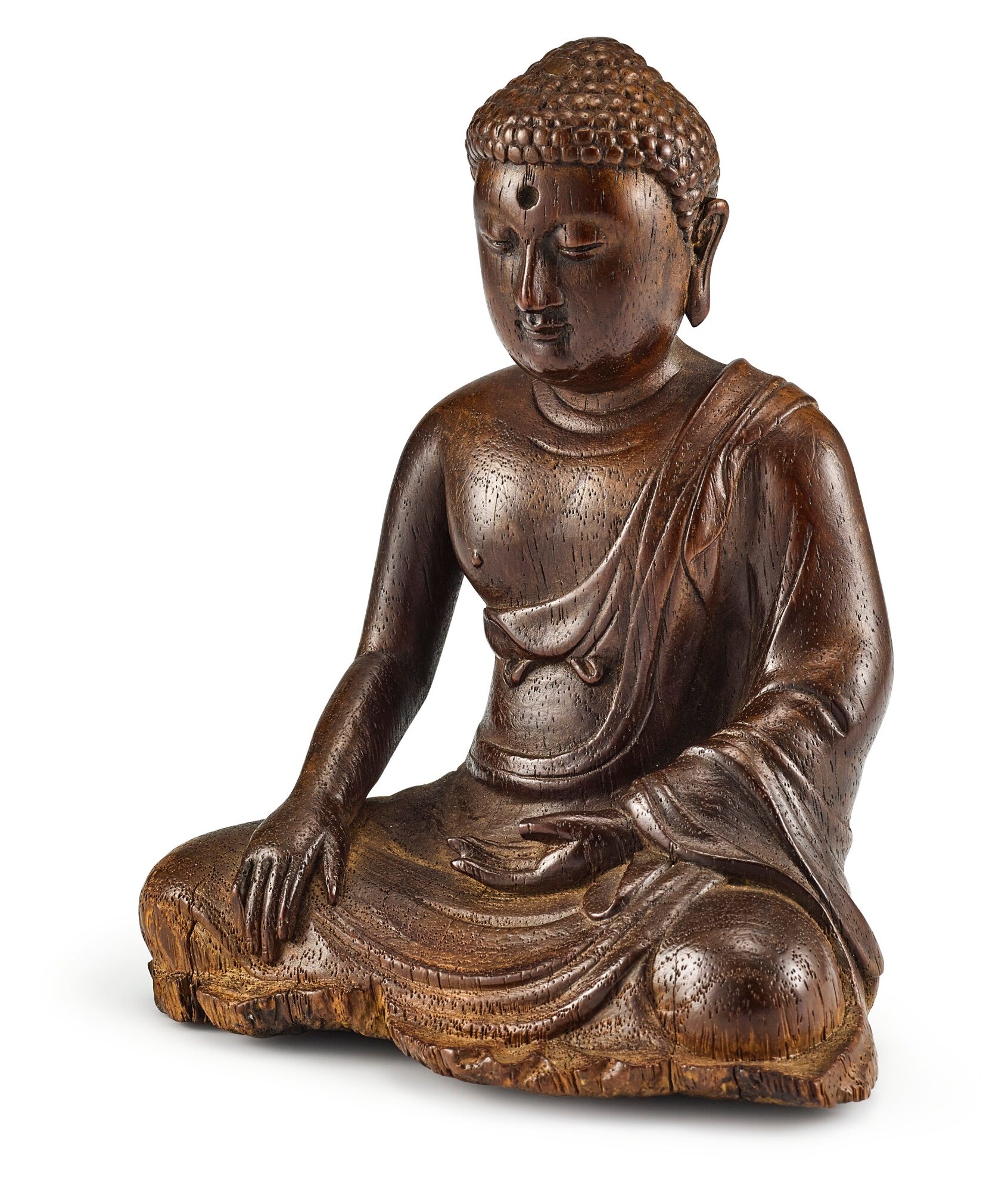
3,000 — 4,000港幣
拍品已售 275,000 港幣 成交價 (含買家佣金)
拍品詳情
清末至民國 木雕釋迦牟尼佛坐像
12.3 公分,4 7/8 英寸
中國藝術品
2018年5月31日 – 2018年6月1日 | 上午 11:15 HKT
香港
参考:佳士得拍賣 2726中國瓷器及工藝精品紐約|2013年9月19日 – 20日拍品1523|PROPERTY FROM A NEW YORK NON-PROFIT INSTITUTION清十八世紀 漆金脫胎佛坐像 18TH CENTURY
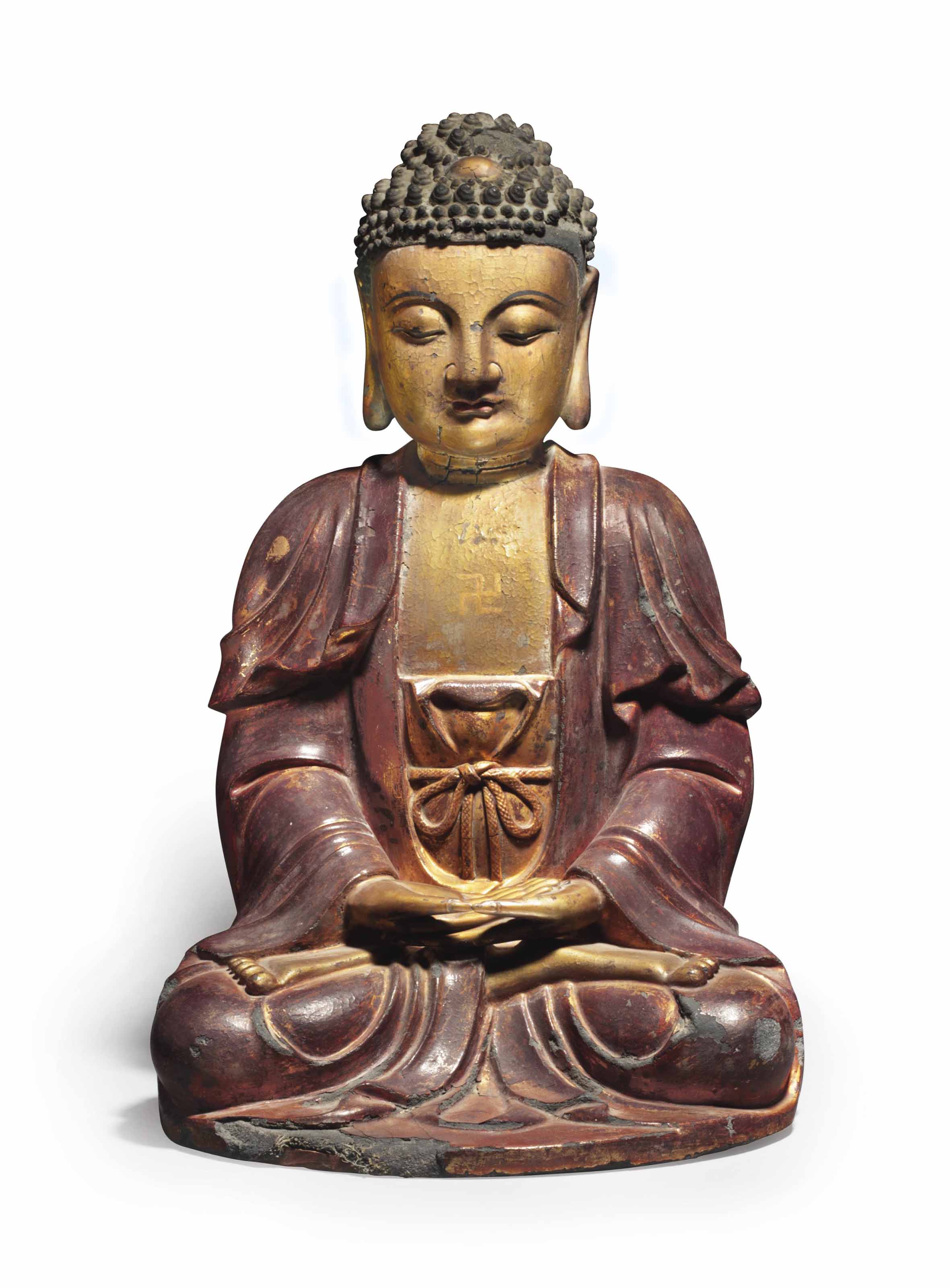
成交總額 USD 8,750
估價 USD 10,000 – USD 15,000
來源
The Horch Family Gift to the Tibet House, 2003.
参考:纽约大都会博物馆 金 木雕釋迦牟尼佛像 Buddha, probably Shakyamuni (Shijiamouni)



12th–13th century
China
Scientific analysis reveals that this sculpture was carved in north China and has a radiocarbon date range of 1040–1260. The simple dress and solemn facial expression of the Buddha are typical of Buddhist sculpture of the Jin dynasty. This Buddha was likely once the main figure of a triad, attended by two bodhisattvas and/or luohans.
On view at The Met Fifth Avenue in Gallery 211
Buddha, probably Shakyamuni (Shijiamouni), Willow wood with pigment, China
Object Details
Period:Jin dynasty (1115–1234)
Date:12th–13th century
Culture:China
Medium:Willow wood with pigment
Dimensions:H. 25 1/4 in. (64.1 cm); W. 18 1/2 in. (47 cm); D. 16 in. (40.6 cm)
Classification:Sculpture
Credit Line:Rogers Fund, 1932
Accession Number:32.148
Timeline of Art History
Timelines
Central and North Asia, 1000-1400 A.D.
China, 1000-1400 A.D.
MetPublications
Wisdom Embodied: Chinese Buddhist and Daoist Sculpture in The Metropolitan Museum of Art
The Metropolitan Museum of Art Bulletin, v. 23, no. 9 (May, 1965)
参考: 拍卖结果 > 巴黎苏富比2018亚洲艺术品秋季拍卖会 > 亚洲艺术 > 清十七至十八世纪 漆金木释迦牟尼佛坐像

拍卖信息
Lot 60 清十七至十八世纪 漆金木释迦牟尼佛坐像

拍卖信息
Lot 60 清十七至十八世纪 漆金木释迦牟尼佛坐像

拍卖信息
Lot 60 清十七至十八世纪 漆金木释迦牟尼佛坐像

拍卖信息
Lot 60 清十七至十八世纪 漆金木释迦牟尼佛坐像

拍卖信息
Lot 60 清十七至十八世纪 漆金木释迦牟尼佛坐像
估价:100,000-150,000 EUR
成交价: 309,000 EUR (含买家佣金)
尺寸:
105.5 公分, 41 1/2 英寸
拍品说明:
瑞士私人旧藏
参考:拍卖结果 > 羅芙奧台北2017春季拍卖会 > 缘来私藏II – 古今人文艺术专场 > 明 宫廷风格 木胎髹漆金释迦牟尼

拍卖信息
Lot 624 明 宫廷风格 木胎髹漆金释迦牟尼

拍卖信息
Lot 624 明 宫廷风格 木胎髹漆金释迦牟尼

拍卖信息
Lot 624 明 宫廷风格 木胎髹漆金释迦牟尼
估价:6,500,000-8,000,000 TWD
成交价: 7,800,000 TWD (含买家佣金)
尺寸: 高55cm
拍品说明:
来源:亚洲藏家旧藏这是晚明时期京工地区宫廷风范的释迦牟尼佛像,兼有汉藏特点,实为传世中的精品。传世的各类造像中,精品木胎造像大多已于晚清民国时期流失海外,加之历史上绵延不断的战火和社会动乱,能留存至今的实为弥足珍贵。木胎造像遍布中国各个地区,各地造像风格不同,形成独自的地域特色,而京工地区宫廷风范的造像,则是集合了各个地区的能工巧匠并且在不惜成本的工艺下制作完成。该尊佛像其螺形发髻细密规整,大耳垂肩,面形圆润,额部宽广; 双目低垂,眉眼到鼻翼的处理过渡得自然流畅;两颊隆满,下颌圆凸,显现了佛陀超于凡俗的庄严和寂静的圆满法相。其上身着袈裟,下身着僧裙,整体浑厚健硕,身姿挺拔,腹部束腰,上身的衣纹翻卷犹如丝织物般有质感,灵动飘逸,极富层次感,突出躯体的自然起伏变化;左手置于膝上,结禅定印,右手置右膝结触地印, 正是释迦牟尼佛于菩提树下降魔成道的姿势和形像;手臂圆润自然,柔然而富有弹性,下身呈跏跌座,盘腿的处理健硕有力。整尊造像工艺精湛,制作考究,内披麻挂灰,外上大漆贴金箔,乃典型木质宫廷风格造像。因年岁久远漆质开片呈蛇腹纹,整身体量巨大,品相完美,雕刻艺术水平极高,更完美诠释了佛陀「相好」的特征,不仅面部神态庄严、慈祥,身姿同样富有美感。流畅的服饰线条与斑驳的岁月之痕,尽显佛像历经的悠悠岁月,成就了一件典型的宫廷风格古代雕塑艺术品。明代宫廷造像由宫廷专设的造像机构——御用监「佛作」具体承办,明人刘若愚《酌中志》中有御用监造办佛像的明确记载。在中原佛教艺术的基础上融入了藏传和尼泊尔造像的特点形成了学术上所说的汉藏风格,这一类汉藏风格多为金铜造像。佛作造像机构除了制作金铜也会有木胎、脱胎夹苎、泥塑等等材质,这些材质多见为汉传气息更浓郁,造型风格更丰富多变,部分兼融入有藏传或尼泊尔的味道。木胎宫廷风格造像因为集合各个主流地区工艺之精华,北方主要为山西地区,南方主要为江浙地区,又以北京地区的审美情趣交融形成独具特色又丰富多变的木胎宫廷风格,与地方造像区别开来。此尊造像正是交融了南方造像、尼泊尔和北京地区的审美而塑造的这样一尊汉藏风格的宫廷风格释迦牟尼佛。此类材质造像多为宫廷或亲王所供奉,用予赏赐西藏僧侣则不多。木质本身具有生命力,与人一种亲近感,中国人对木也有一种特殊的情感,如同中华文化赋予造像艺术特有的意像性特征,数百年的时光也如赋予木材质独特的韵味,这种韵味封存在木造像的「包浆」或「皮壳」中。尘灰、汗水、空气中的水分、经久的摩挲擦拭、烟熏火燎,在木质上层层积淀,逐渐形成表面的皮壳。这些以造像为载体的岁月留痕,显露出温存的旧气,更自然温润,更能打动心灵。
参考:LOT 56
IMPORTANTE STATUE DE BOUDDHA AMITABHA EN BRONZE DORE
CHINE, ROYAUME DE DALI, PROVINCE DU YUNNAN, XIIEME – XIIIEME SIECLE
Price realised EUR 482,500
Estimate EUR 150,000 – EUR 200,000
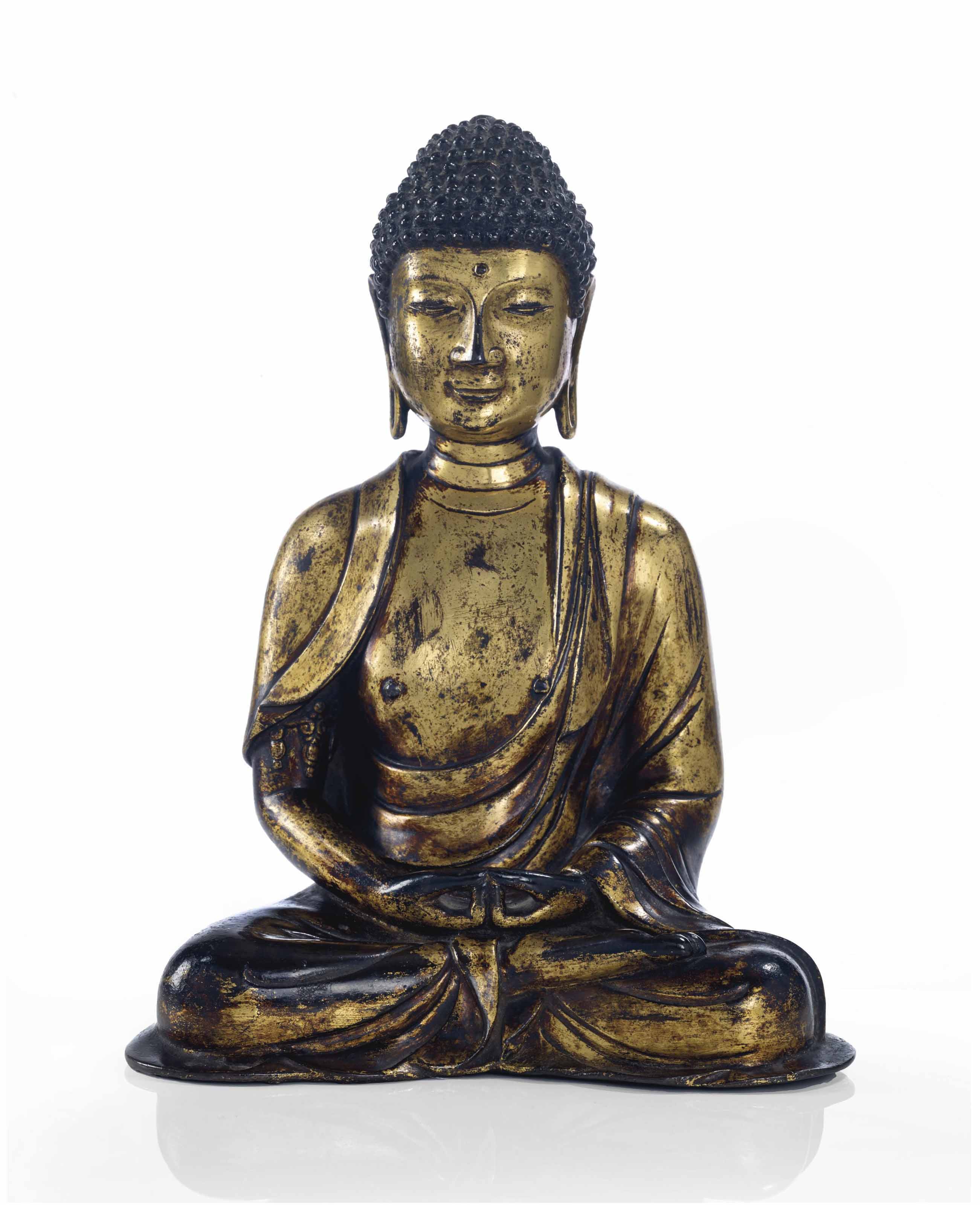
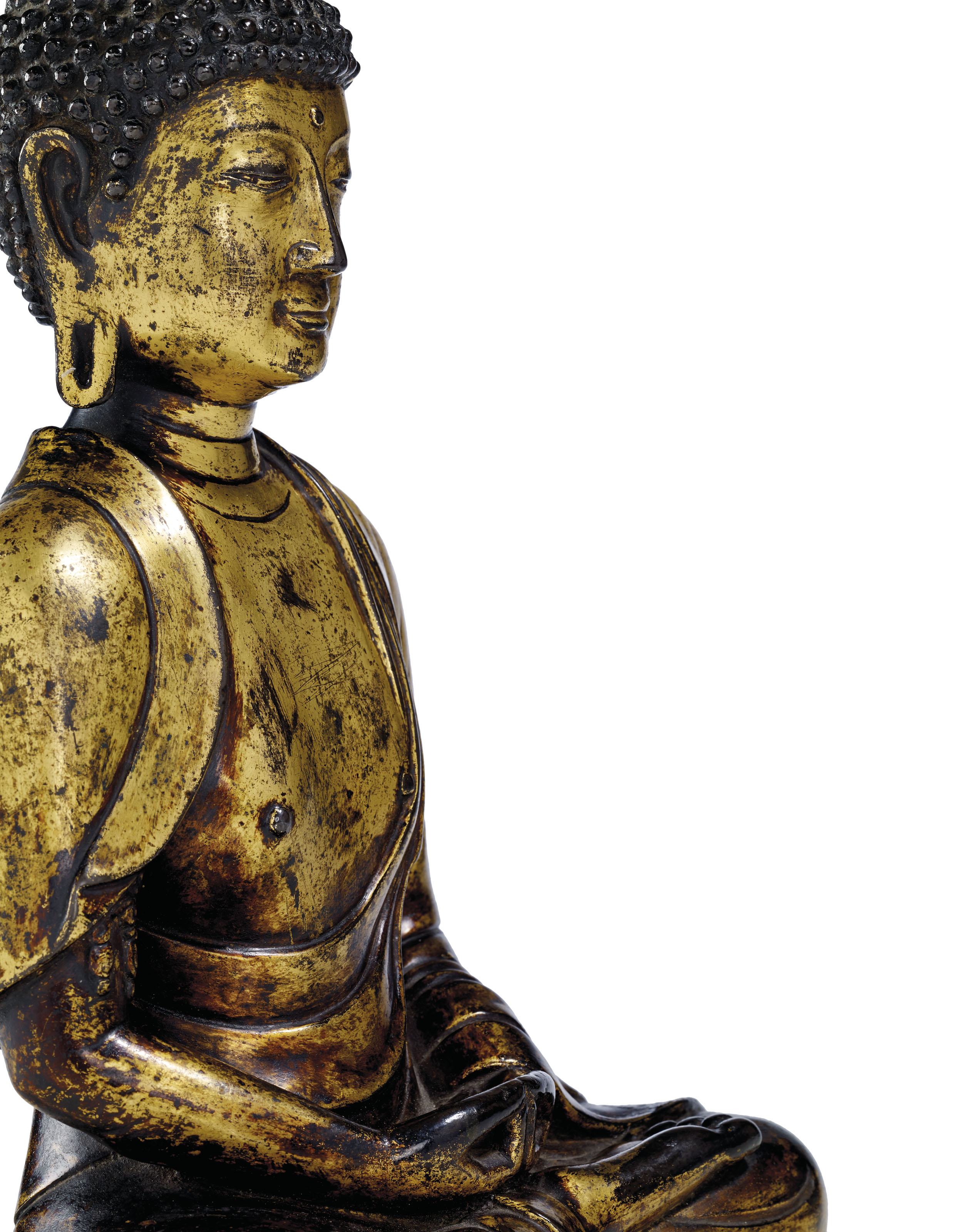
IMPORTANTE STATUE DE BOUDDHA AMITABHA EN BRONZE DORE
CHINE, ROYAUME DE DALI, PROVINCE DU YUNNAN, XIIEME – XIIIEME SIECLE
Il est représenté assis en sattvasana, les mains en dhyanamudra, vêtu d’une robe monastique plissée couvrant ses épaules. Son visage est serein, les yeux mi-clos surmontés de sourcils arqués, ses lobes d’oreille allongés, le front agrémenté de l’urna. Ses cheveux bouclés sont surmontés de l’ushnisha rehaussée du ratna.
Hauteur : 28 cm. (11 in.)
Provenance
Private Belgian collection before 1967.
Private Belgian collection acquired on 7 March 1967, Brussels.
Lot Essay
The contemporaneous Dali (957-1253) and Liao (916-1125) kingdoms both promoted Buddhism. They made sculptures in the style that descended from the Tang Dynasty (618-907). As a result, Liao and Dali sculptures are closely related in style and general appearance. In fact, previously, the very rare Dali sculptures were often mistaken for the more commonly seen Liao sculptures (see for a Liao example, lot 49). Buddha images from the Dali kingdom show heads that are relatively large in proportion to their shoulders and a low cranial protuberance that are often embellished with a ratna at the front, as this sacred image demonstrates.
The half-closed eyes look directly outward – in contrast to the large heavily lidded eyes of Tang and Liao sculptures, pointing to this sculpture’s origins in the Dali kingdom. The current Buddha’s monastic robe crosses both shoulders and descends to the abdomen. Its edge folds into an undulating curvy configuration, characteristic of Buddha images from the Dali Kingdom. A last feature of Dali Buddha examples is the armlet decoration on the right upper arm.
The Buddha is very similar in style to an example in the Shanghai Museum, which bears an inscription dating it to the mid 12th century. The resemblance to the Shanghai sculpture suggests a 12th to 13th century date for this magnificent Buddha.
A comparable fine example was sold at Christie’s, New York, 20 March 2014, lot 1611.
Post Lot Text
AN IMPORTANT GILT-BRONZE FIGURE OF BUDDHA AMITABHA
CHINA, DALI KINGDOM, YUNNAN PROVINCE, 12TH – 13TH CENTURY
参考:LOT 86
STATUE DE BOUDDHA AMIDA EN BOIS LAQUE OR
JAPON, EPOQUE KAMAKURA (1185-1333)
Price realised EUR 104,500
Estimate EUR 35,000 – EUR 45,000



STATUE DE BOUDDHA AMIDA EN BOIS LAQUE OR
JAPON, EPOQUE KAMAKURA (1185-1333)
Il est représenté assis en vajrasana,ses mains en dhyanamudra. Il est vêtu d’une robe monastique plissée. Son visage est serein, ses yeux mi-clos incrustés, le front décoré d’un urna incrusté et les lobes d’oreille allongés. Les cheveux bouclés sont coiffés en chignon agrémentés de l’ushnisha et du ratna incrusté.
Hauteur : 38 cm. (15 in.)
Provenance
Private American collection, acquired in Japan in the late 1940s (by repute).
The sculpture may have been on loan at the Fogg Art Museum, Harvard University, Cambridge, USA (by repute).
Private French collection, acquired from Shirley Day in New York, 21 March 2008.
Lot Essay
A radiocarbon dating test (Paleo Lab, Japan, Reference RCPL/16/055) dated 6 July 2016, consistent with our dating, is available on request.
A GILT-LACQUERED WOOD FIGURE OF BUDDHA AMIDA
JAPAN, KAMAKURA PERIOD (1185-1333)

![[临渊阁]天地一家春](https://www.antiquekeeper.ca/wp-content/uploads/2023/03/cropped-Asian-Art-Wallpaper-Painting3-6-1.jpg)
